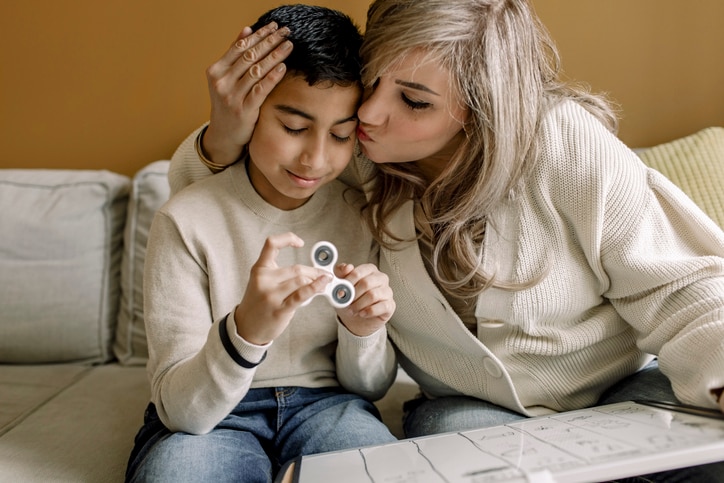In this article
Autistic person or person with autism — which is the more inclusive, sensitive language preferred by the community? In many, but not all, cases, it’s the former. However, keep in mind, in the past few years, language has evolved quite a bit, and ultimately, the terminology is not one-size-fits-all.
“When it comes to saying ‘person with autism’ or ‘autistic person,’ this should always be a personal choice to the individual themselves, so just ask what their preference is!” says Alyssa Latham, a board-certified behavior analyst and parent coach at Ally Behavior Centers, which supports the development of neurodivergent kids.
“As professionals and educators, it was drilled into our heads that we should always use person-first language, such as ‘person with autism,’ because it was viewed as more respectful, and their diagnosis does not define them. But alternatively, many autistic individuals have stated that they cannot separate themselves from autism, meaning being autistic is who they are, therefore they prefer to identify as ‘autistic.’”
Here’s what else to know about the terminology and the differences between autism vs. autistic.
Key takeaways
- Language around autism is evolving, and whether to say “autistic person” or “person with autism” depends on individual preference — the most respectful approach is simply to ask. Many in the autistic community now favor identity-first language (“autistic person”) as it reflects pride and inseparability from their identity.
- Terms like “Autism Spectrum Disorder” and “non-verbal” are being replaced with more inclusive alternatives like “autism” and “non-speaking,” which emphasize differences rather than deficits. This shift reflects the broader neurodiversity movement that views autism as a natural variation in human experience, not a disorder to be cured.
- Ultimately, inclusivity in language means honoring personal choice and acknowledging diversity within the autism community. Using mindful, respectful words — and being open to correction — helps foster understanding and acceptance for all neurodivergent individuals.
“Disorder” or “ASD” is frowned upon
Ann Carrick, communications manager at the Madison House Autism Foundation in Rockville, Maryland, an organization that focuses on autistic people in the older population, notes that the community, and those trying to be inclusive and sensitive, generally avoids using the term “Autism Spectrum Disorder,” or “ASD,” since “a lot of the autism community is very vocal about not wanting it to be viewed as a disorder, but rather a different way of thinking that often comes with a set of challenges.”
Chloe Duckworth, the co-founder and CEO of Valence Vibrations, an emotion AI company that creates real-time emotional subtitles as a digital accessibility solution for neurodiverse teams. adds: “When one believes that autism is a disorder that needs to be cured, saying ‘person with autism’ is no different than saying ‘person with cancer.’”
That being said, Latham notes: “While many people do not think of autism as a ‘disorder,’ because that lends to the idea that autism is something to be ‘cured,’ ASD is the official diagnosis in the DSM-V. It’s important to know that receiving this official diagnosis opens doors to access supports and accommodations that the individual might need.”
“Examples of supports,” she continues, “could include insurance coverage for therapy services, prescriptions to medications, Individualized Education Plan [IEP] in the school setting and more.”
“Many teenagers and adults see autism as part of their identity, so they prefer ‘autistic.’ With younger kids who aren’t yet part of the self-advocacy movement, their parents may prefer ‘child with autism.”
— Jenny Root, board-certified behavior analyst
Person-first language vs. identity-first language (autism vs. autistic)
“In the autism community, there has been a shift in whether to use person-first language, such as, ‘a child with autism’ or identity-first language like, ‘autistic child,’” explains Jana Sarno, a board-certified behavior analyst and chief clinical officer at Hopebridge Autism Therapy Centers.
“Historically, the language was person-centered, but since the neurodiversity movement, society has started to honor, accept and better understand everyone’s uniqueness, as many adults in the autism community feel like autism is part of their identity.”
Jenny Root, a board-certified behavior analyst and associate professor of Special Education in the School of Teacher Education at Florida State University, notes that it’s fairly common for first-person language to be used initially with children and identity-first language for adults. The reason being, kids can’t really voice what their preference is at this point.
“Many teenagers and adults see autism as part of their identity, so they prefer ‘autistic,’” Root says. “With younger kids who aren’t yet part of the self-advocacy movement, their parents may prefer ‘child with autism,’ particularly if they’re very young and/or need a lot of support.”
Again, though, the best way to determine what a person or family prefers is to ask.
Sarno explains that instead of having a one-term-fits-all policy at Hopebridge, they leave the choice up to families. “We acknowledge the history of how this language has changed and believe the choice is up to the families, as well as the children themselves, once they are able to make that distinction,” she explains. “Because we primarily serve children 5 years and younger, many of our families are newer to autism. Because of this, we typically use person-first language. However we shift that language if a parent refers to their ‘autistic son,’ for instance. It’s important to honor a family’s preferences and mirror their language.”
Non-verbal vs. non-speaking
Another term in the autism community that has shifted recently is “non-speaking,” which is generally preferred to “non-verbal,” as the latter indicates a person can’t communicate, when in reality, they’re just not using spoken words.
“While the term ‘non-verbal’ is widely-used within the autism community, ‘non-speaking’ or ‘non-vocal speakers’ are typically more accurate when referring to an individual who does not vocally communicate,” Sarno explains.
“‘Non-vocal speaker’ is broader, recognizes receptive language and includes those who use AAC devices or sign-language to communicate,” Sarno continues. “It also does not exclude those who are able to vocally speak but choose not to do so. Even better than either term is referring to what the individual uses as a communication modality rather than the method in which they do not communicate.”
“Language is constantly evolving, but it’s important to try to use words that are mindful, inclusive and respectful of others while honoring diversity and uniqueness.”
— Jana Sarno, board-certified behavior analyst
Why is the community is moving away from person-first language?
The initial goal behind the encouragement of using person-first language, such as “a person with autism,” was to put the person ahead of their diagnosis. However, as self-advocacy has become more pervasive, many in the autism community have voiced the fact that they prefer the opposite and have done so for quite some time (everyone else is just playing catch-up).
“The neurodiversity movement shows that autism is simply a different sensory processing system that needs different tools to make sense of a world that isn’t designed for autistic people,” says Duckworth. In this sense, autism cannot be removed from one’s identity, and just as it would be strange and offensive to say ‘person with tallness’ or ‘person with queerness.’ Autistic people overwhelmingly prefer identity-first language — autistic person — over person-first language — people with autism.”
A 2022 survey from Autistic Not Weird found that, out of the over 11,000 people that were polled (both autistic and non), over 76% of autistic participants only refer to themselves using identity-first language.
“This debate has existed in the community for a long time because neurotypical professionals in the space insist on anti-neurodiversity language to emphasize the medical model of disability over the social model of disability,” Duckworth adds.
A final word on using “autistic person” vs. “person with autism”
“When discussing autism and other diagnoses in more general terms, terminology like ‘neurodiversity’ and ‘differing abilities’ are also appropriate,” says Sarno. “Many people find words and phrases like these to be more inclusive, understanding and accepting than terms such as, ‘disability,’ ‘special needs’ or ‘problems.’”
“Language is constantly evolving, but it’s important to try to use words that are mindful, inclusive and respectful of others while honoring diversity and uniqueness,” she continues. “Many times, there is not only one correct way to say something.”





